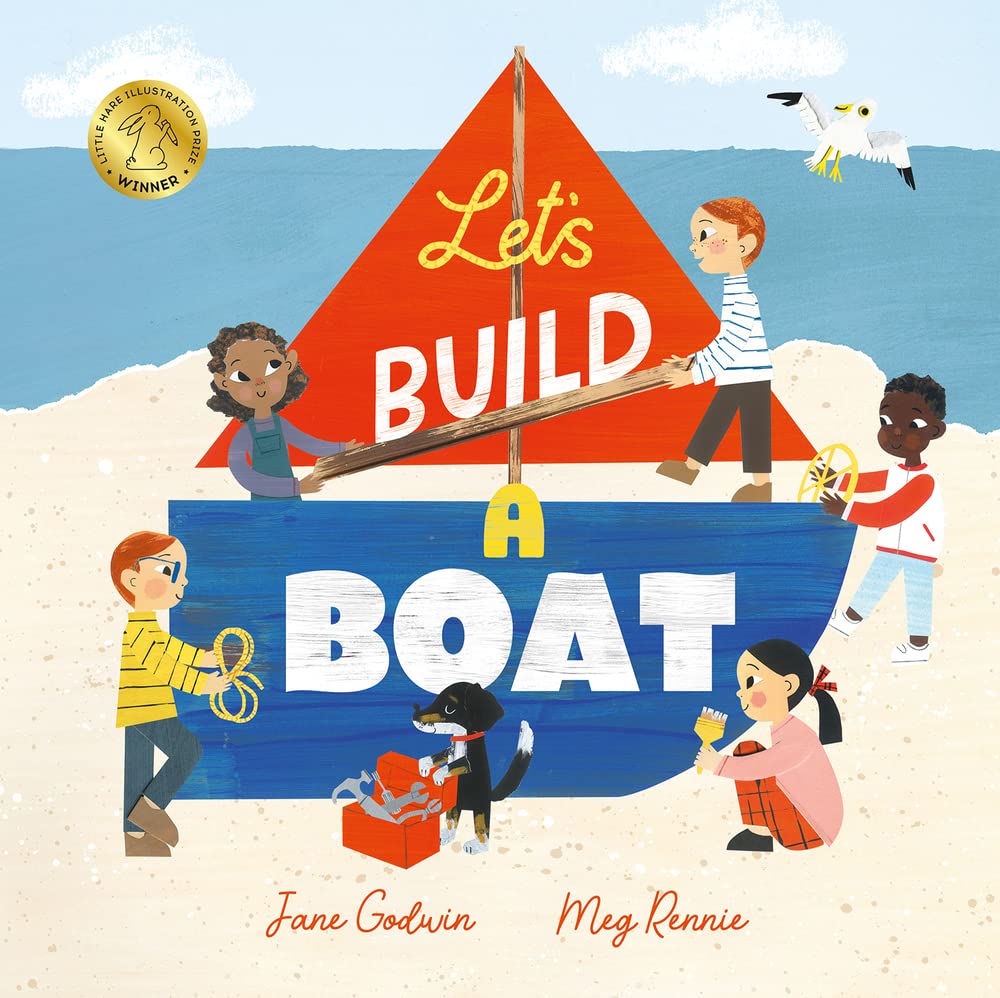On this page
- Introduction
- Lesson Sequence & Elaboration
- Lessons 1 & 2 – Background Knowledge and Prediction
- Lesson 3 – Personal Connection and Early Design Thinking
- Lesson 4 – Retrieval and Understanding
- Lesson 5 – Text Comparison and Materials Experimentation
- Lesson 6 – Planning and Sequencing Steps
- Lessons 7 & 8 – Making the Boats
- Lesson 9 – Making References and Vocabulary
- Lessons 10 & 11 – Evaluation of Text and Boat
- Key Takeaways
- Conclusion
Introduction
Planning a T4R unit around Let’s Build a Boat by Jane Godwin blends literacy and design learning into a cohesive journey. Children not only practise comprehension but also experience the development process of planning, making, and evaluating.
This Literacy and Designing unit is planned based on the following synopsis:
By the end of the unit, students may be able to:
- Recognise that creating things is fun, and teamwork helps make it possible.
- Identify similarities and differences between boats in different texts.
- Justify their opinions by making personal connections and referring to the story.
- Understand the development process: planning, choosing materials, following steps, and revising.
- Justify their own boat or raft design, linking its features to the text.
Because this unit is a combination of reading comprehension and designing skills, the lessons are sequenced to balance both aspects. Some lessons focus on comprehension strategies through Talk for Reading (T4R), while others weave in design thinking from the Design and Technologies curriculum.
We recommend reading our article on Let’s Build a Boat as a quality text to see why this book is a valuable example of children’s books that connect literacy with engineering and design learning.
Lesson Sequence & Elaboration
| Lesson 1 We are learning to build our background knowledge to help us comprehend a text. Warm-up: Have you ever made something? What is it? How did you feel when you made it? Book introduction: Explore the cover and title. Video: How to make a simple boat. Discuss. Activity: Wonderings page. Elaboration | Lesson 2 We are learning to make predictions about the text. Warm-up: What do you think is happening in the story? How do you know? Reading (dialogic): List of predicting questions. Discussion: What’s the story about? Why did they make the boat? Activity: Add more details into the wonderings page. Elaboration | Lesson 3 We are learning from the characters to make a good boat. Warm-up: Discuss materials and parts of the boat in the story. Reading: Take notes as reading. Discussion: What does the boat remind you of? If you made your own boat, what would it look like? Activity: Design a boat using drawing and describing (materials). Elaboration | Lesson 4 We are learning to find some information from the text to help us understand it. Warm-up: What happens at the beginning/middle/end of the story? Reading: Ask children to remember as much as they can. Q&A: Go through the question bank with the whole class. Activity: Info retrieval worksheet. Elaboration | Lesson 5 We are learning to compare boat issues in a different text to make a good boat. Warm-up: What’s the problem with the boat on the way home? Text comparison: Let’s find out what’s the problem of the boat in this text. Discuss: How to make a good boat? Experiment: Testing materials (the boat base only.) Activity: Material worksheet. Elaboration |
| Lesson 6 We are learning to write instructions how to make a good boat. Warm-up: Observe the sample raft. Discussion: The steps to make the raft. Reading (p2-7): Learn from the kids in the book → Create the steps and materials to make a raft. Video: How to make a raft. Activity: Write the procedure. Elaboration | Lesson 7 We are learning to make a raft. Expectation: Discuss safety Demonstration: Use their procedure/sample procedure to help. Testing: Put 5 mini humans on the raft for testing. Remaking: Add more materials to make it float. Elaboration | Lesson 8 We are learning to make a raft. Continued from Lesson 7. Elaboration | Lesson 9 We are learning to make inferences about the text and understand the message of the text. Vocabulary: Go through the unknown words. Reading: Chunk by chunk reading, stop to clarify meaning when needed. Making inferences: What does the author mean: the wind blows up, waves crash… ? Sharing: Did anyone help you during the making? Elaboration | Lesson 10 We are learning to summarise the story. Warm-up: One thing you remember about the story? Reading: Chunk by chunk as a whole class. Summarising: Using a narrative structure to guide. Activity: Summarising sheet. Finishing off making their raft. Elaboration |
| Lesson 11 We are learning to evaluate and reflect on the text and your boat. Elaboration |
Lessons 1 & 2 – Background Knowledge and Prediction
Using the T4R sample unit template, the first two lessons focus on activating background knowledge and making predictions. These sessions draw children into the topic of boats and introduce the idea of using essential materials for planning and making.
Lesson 3 – Personal Connection and Early Design Thinking
Here, I begin to blend in planning skills from Design and Technologies. Children notice the boat parts and materials used by the kids in the story and start thinking about what they’d like in their own boat. Perhaps a mast, a steering wheel, or favourite colours. This activity introduces early performative designs, where students connect personal choices with practical features.
Lesson 4 – Retrieval and Understanding
The language in Let’s Build a Boat is quite simple, so I won’t dedicate a whole lesson to vocabulary. Instead, I explain new words as they arise naturally. This frees up the lesson to focus on retrieval questions, helping students strengthen comprehension and deepen their understanding of the development process in the story.
Lesson 5 – Text Comparison and Materials Experimentation
We dig deeper into the challenge caused by the storm in the story. Children compare this to Pamela Allen’s Who Sank the Boat? so they can think critically about what makes a boat strong or weak.
We then experiment with different materials to see which ones withstand water, weight, or movement best. This fun testing stage introduces practical science and engineering links, showing children how material choice impacts design.
Lesson 6 – Planning and Sequencing Steps
After deciding on suitable materials, it’s time to think about the steps to build a boat. I provide a simple raft model as a demonstration. While some students may write the steps, I encourage them to explain verbally how they would build it. This activity highlights the development of procedural understanding.
Lessons 7 & 8 – Making the Boats
Now comes the highlight: children begin making their own boats using the chosen materials. These sessions are highly engaging and allow children to apply their plans in real time. It’s also a good time to talk about safety and the collaborative benefits of working with peers, reminding them that asking for help is an important part of the development process.
Lesson 9 – Making References and Vocabulary
We return to the T4R template with making references to identify the story’s key message. This is also where I formally include vocabulary, reinforcing the words introduced earlier and ensuring children understand and can use them.
Lessons 10 & 11 – Evaluation of Text and Boat
Following the T4R sequence, these lessons focus on evaluation. Children reflect on the story and its meaning, but also evaluate their own boats. Did their design work as expected during testing? What could they improve next time? This dual evaluation builds resilience and problem-solving skills.
Check out our complete T4R unit of Let’s Build a Boat here:
Key Takeaways
- Plan with intention: I use a post-it note for each lesson, with just bullet points outlining the sequence. This makes it easy to refine and re-order lessons. I also revisit the unit synopsis, along with the English and Design and Technologies curriculums, to ensure the lessons meet learning outcomes.
- Be flexible with the template: You don’t need to follow the T4R sequence rigidly. Adjust the flow so it serves your purpose. In this unit, my purpose is clear: Strengthening literacy while fostering design and making through Design and Technologies.
- Allow for imperfection: The first attempt at teaching a unit is rarely perfect. Be prepared to reflect and adjust as you go, and don’t worry if things don’t unfold exactly as planned.
Conclusion
By integrating reading, engineering concepts, and practical boat-making, this unit highlights the joy of performative designs and the real-world collaborative benefits of teamwork. Just as building a boat takes tools, testing, and adjustments, so too does planning a teaching unit—both are challenges worth embracing for the rich learning they create.




![[T4R] Let’s Build a Boat: L1 Background Knowledge [T4R] Let’s Build a Boat: L1 Background Knowledge](https://stevendegc.com.au/wp-content/uploads/2025/05/LetsBuildaBoat-T4R-L1-Cover-1024x626.jpg)
![[T4R] Let’s Build a Boat: L2 Making Predictions [T4R] Let’s Build a Boat: L2 Making Predictions](https://stevendegc.com.au/wp-content/uploads/2025/05/LetsBuildaBoat-T4R-L2-Cover-1024x627.jpg)
![[T4R] Let’s Build a Boat: L3 Making Connections [T4R] Let’s Build a Boat: L3 Making Connections](https://stevendegc.com.au/wp-content/uploads/2025/05/LetsBuildaBoat-T4R-Lesson3-Cover-1024x625.jpg)
![[T4R] Let’s Build a Boat: L4 Literal Retrieval [T4R] Let’s Build a Boat: L4 Literal Retrieval](https://stevendegc.com.au/wp-content/uploads/2025/05/LetsBuildaBoat-T4R-Lesson4-Cover-1024x626.jpg)
![[T4R] Let’s Build a Boat: L5 Connecting to a Different Text [T4R] Let’s Build a Boat: L5 Connecting to a Different Text](https://stevendegc.com.au/wp-content/uploads/2025/05/LetsBuildaBoat-T4R-Lesson5-Cover-1024x626.jpg)
![[T4R] Let’s Build a Boat: L6 Writing a Boat-making Procedure [T4R] Let’s Build a Boat: L6 Writing a Boat-making Procedure](https://stevendegc.com.au/wp-content/uploads/2025/05/LetsBuildaBoat-T4R-Lesson6-Cover-1024x626.jpg)
![[T4R] Let’s Build a Boat: L7 Making a Raft [T4R] Let’s Build a Boat: L7 Making a Raft](https://stevendegc.com.au/wp-content/uploads/2025/05/LetsBuildaBoat-T4R-Lesson7-Cover-1024x625.jpg)
![[T4R] Let’s Build a Boat: L8 Testing the Raft [T4R] Let’s Build a Boat: L8 Testing the Raft](https://stevendegc.com.au/wp-content/uploads/2025/05/LetsBuildaBoat-T4R-Lesson8-Cover-1024x626.jpg)
![[T4R] Let’s Build a Boat: L9 Making Inferences [T4R] Let’s Build a Boat: L9 Making Inferences](https://stevendegc.com.au/wp-content/uploads/2025/05/LetsBuildaBoat-T4R-Lesson9-Cover-1024x625.jpg)
![[T4R] Let’s Build a Boat: L10 Summarising [T4R] Let’s Build a Boat: L10 Summarising](https://stevendegc.com.au/wp-content/uploads/2025/05/LetsBuildaBoat-T4R-Lesson10-Cover-1024x626.jpg)
![[T4R] Let’s Build a Boat: L11 Evaluation and Reflection [T4R] Let’s Build a Boat: L11 Evaluation and Reflection](https://stevendegc.com.au/wp-content/uploads/2025/05/LetsBuildaBoat-T4R-Lesson11-Cover-1024x626.jpg)
Leave a Reply